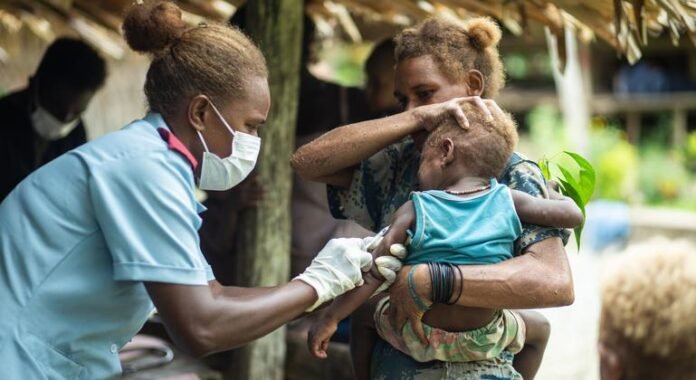Since 1948, this specialized United Nations health agency has been dedicated to the well-being of all people, from the laboratory to the battlefield.
It operates on the principles of science and with the support of its 194 member countries, including the United States.
The US, which on Monday announced its withdrawal from the organization under new President Donald Trump, is actually a co-founder of the organization.
What has the World Health Organization (WHO) done for the world? The short answer is – a lot.
This UN agency is currently working on the health front with its member countries in more than 150 locations. It has made many important achievements in the field of public health.
Here are some facts for your information about the world’s largest health institution:
Dealing with emergencies
WHO has responded to crisis, war and conflict, disease outbreaks and the constant threat of climate change to deliver life-saving vaccines and medical supplies to remote and dangerous areas, including the war-torn regions of Gaza, Sudan and Ukraine.
Healthcare is facing unprecedented risks. In 2023, WHO recorded more than 1,200 attacks on health workers, patients, hospitals, clinics and ambulances in 19 countries and regions, resulting in more than 700 deaths and nearly 1,200 injuries.
WHO teams often reach places that are impossible for other individuals and organizations to reach. They routinely evacuate injured patients and deliver life-saving equipment, supplies and services to conflict or disaster-affected areas.
WHO teams, in September 2024, supported the implementation of a multi-agency polio vaccination campaign in the war-torn region of Gaza. After 25 years of complete eradication in the area, this fast-spreading virus has resurfaced.
Health crisis monitoring and resolution
Every day and throughout the night, WHO’s teams of experts examine a wide range of data, such as scientific papers and disease surveillance reports, to identify signs of disease outbreaks or other public health threats. These include threats ranging from avian flu to COVID-19.
WHO works to prevent, detect and treat infectious disease outbreaks and strengthen access to essential health services.
This includes increasing the capacity of hospitals to handle every type of health response, from delivering babies to treating war-wounded people and training health workers.

Global disease eradication
Many diseases can be eliminated through proper public health policies. These include neglected infectious and vector-borne diseases, sexually transmitted infections, mother-to-child transmission, and vaccine-preventable diseases.
The United Nations Health Organization works to increase laboratory capacity to diagnose diseases, as well as provide essential drugs and medical equipment.
In 2024, WHO Member States have made several important achievements in addressing these major global health challenges.
Seven countries (Brazil, Chad, India, Jordan, Pakistan, Timor-Leste and Vietnam) have eliminated several tropical diseases, including leprosy and trachoma.
Mother-to-child transmission of HIV and syphilis has stopped in Belize, Jamaica and St. Vincent and the Grenadines, and Namibia has made significant progress toward eliminating mother-to-child transmission of HIV and hepatitis B.
WHO has played an important role over the past seven decades, including the eradication of smallpox in the 1980s, the near eradication of polio and the provision of life-saving assistance during the recent war in Gaza.

AI and Digital Health
WHO is taking steps towards adopting new technologies like artificial intelligence (AI) in digital health.
WHO is striving to ensure its safety and efficacy for health amid the growing impact of emerging AI technologies.
This includes new guidelines published in October (2024). These present important regulatory considerations on issues such as the potential use of AI to diagnose or treat conditions such as cancer or tuberculosis.
Additionally, there is a focus on mitigating risks such as unethical data collection, cyber security threats, and the spread of bias or misinformation.

Facing a severe climate-related health crisis
At least 3.5 billion people are affected by climate-related health crises. That’s almost half of the world’s population.

In 2023, millions of people died due to extreme heat, extreme weather events and air pollution, putting enormous pressure on health systems and the working population.
Its effects can be seen today from wildfires raging on America’s West Coast to devastating floods in Indonesia.
Part of WHO’s work is to protect health from the wider impacts of climate change, including assessing vulnerability and developing plans.
The UN agency is working to implement response mechanisms to major threats such as extreme heat and infectious diseases, and to support resilience and adaptation in health-critical sectors such as water and food.
What is WHO currently doing?
WHO is leading efforts for a global agreement, a comprehensive approach to strengthen pandemic prevention, preparedness and response. It is based on the same principles adopted by the founders of the International Health Conference in 1851.
This UN agency is working towards the goal of tripling one billion.
Under these goals set in 2019, by 2025, one billion more people will enjoy universal health coverage, one billion more people will be better protected from health emergencies, and one billion more people will enjoy better health and well-being.
Who led the WHO?
WHO’s leadership is truly international. The Geneva-based UN agency is currently headed by its Director-General, Dr. Tedros Adhanom Ghebreyesus.
The approved biennial program budget for 2024-2025 is $6.83 billion, which comes from member states’ assessments and voluntary contributions.
World Health Assembly, WHO’s decision-making body (World Health Assembly) consists of representatives of member countries and meets annually to agree on WHO’s priorities and policies.
Member States decide on health goals and strategies that guide their own public health work and the WHO Secretariat’s efforts to move the world towards better health and well-being for all.
It also includes corrective measures that have made WHO more effective.

